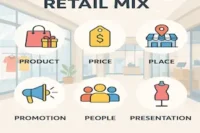What Is Retail Mix?
Published: 26 Jul 2025
In the dynamic world of retail, success doesn’t come from chance — it stems from strategy. At the heart of every successful retail business lies a well-crafted Retail Mix.
Also known as the 6 Ps of Retailing, the retail mix is a strategic framework that retailers use to deliver value to customers, differentiate their brand, and drive profitability.
Here’s what the retail mix is, the 7Ps of retail mix, why it’s important, and some examples of retail mix to help you easily understand it.
So guys, let’s come and explore the whole guide without wasting time.
What Is Retail Mix?
Retail mix refers to the combination of key strategies that a retailer uses to meet customer needs and achieve business goals. It includes six main elements:
- Product
- Price
- Place
- Promotion
- presentation and
- People.
Each part plays an important role in shaping the overall shopping experience.
For example,
- Offering the right products at competitive prices in a convenient location
- Supported by effective promotions
- A well-designed store layout and trained staff—this is how a strong retail mix works.
When used effectively, the retail mix helps businesses attract customers, increase sales, and build long-term loyalty.
How Does Retail Mix Work?
Retail mix works by combining six important elements;
- Product
- Price
- Place
- Promotion
- Presentation and
- People—to create a smooth and satisfying shopping experience for customers.
Each part supports the others. For example, a store may offer a popular product (product) at a reasonable price (price) in a busy shopping area (place). They might promote it through ads or discounts (promotion), display it neatly and attractively (presentation), and have friendly staff ready to help (people).
When these parts work together, they guide the customer from interest to purchase without confusion or frustration.
The goal of the retail mix is to meet the needs of the target customer while helping the business grow. A good retail mix can turn first-time shoppers into loyal customers.
For instance, if a toy store knows parents want safe, affordable toys in a clean, cheerful space, it can use the retail mix to deliver exactly that. By carefully planning each element, retailers can stand out from the competition, build trust, and create lasting value.
What Are the 6 Ps of the Retail Mix?
The 6 Ps of the retail mix are the key tools retailers use to attract customers and grow their business. When all six elements work together, they help create a smooth and enjoyable shopping experience for buyers. Let’s look at each one in detail.
Product
Product refers to the goods or services a retailer offers to meet customer needs. Choosing the right product is the first step to making a sale.
It must match what the customer is looking for in terms of quality, style, and usefulness. A strong product offering builds trust and encourages repeat visits. So make sure to always,
- Offer items that meet customer needs and trends
- Include variety in size, color, style, or category
- Ensure good quality and reliable performance
- Add value with exclusive or unique products
- Update stock regularly to stay relevant
Price
Price is the amount customers pay for a product. It must reflect both the value of the item and what the customer is willing to pay.
A smart pricing strategy builds customer confidence and helps the business stay competitive.
- You should use fair and competitive pricing
- Offer discounts or bundle deals to attract buyers
- Match prices to customer expectations and income levels
- Adjust prices based on demand or seasons
- Create pricing that supports both value and profit
Place
Place refers to where and how the product is offered to customers. This could be a physical store, an online shop, or both.
The right place makes shopping easier, faster, and more convenient for the customer.
- Always choose locations with good foot traffic
- Use online platforms for a wider reach
- Offer delivery or pickup options
- Make the shopping space easy to navigate
- Ensure products are always available where needed
Promotion
Promotion is how retailers tell people about their products and services. It helps create awareness, build interest, and drive sales. Effective promotion makes sure the right message reaches the right audience at the right time.
- Use advertising to reach more people
- Run special offers or seasonal sales
- Promote through social media and email
- Use posters, signs, or banners inside the store
- Reward loyal customers with deals or points
People
People are the staff who interact with customers. They play a key role in creating a good shopping experience. Friendly, helpful employees can make customers feel welcome and valued.
- Train staff to provide great customer service
- Hire people who understand the brand and products
- Encourage staff to be helpful, kind, and professional
- Reward employees who go the extra mile
- Make sure there is enough staff available during busy times
Presentation
Presentation is how the store looks and feels. It includes layout, lighting, product displays, cleanliness, and even music. A good presentation can attract customers and keep them engaged.
- Keep the store clean and well-organized
- Use signs and labels that are easy to read
- Create eye-catching product displays
- Use lighting to highlight key areas
- Set a mood with music, colors, and scent
Each of these 6 Ps plays an important role in retail success. When they are used together with care, they help create a shopping experience that brings people back again and again.
Why Is the Retail Mix Important?
The retail mix is important because it helps businesses meet customer needs while staying competitive in a fast-changing market. Each part of the mix
- Product
- Price
- Place
- Promotion
- People and
- Presentation—works together to create a smooth and enjoyable shopping experience.
When retailers get the mix right, they build customer trust, increase sales, and set themselves apart from competitors. A strong retail mix doesn’t just attract customers—it keeps them coming back.
In today’s retail world, where choices are everywhere, businesses must do more than just sell products. They must deliver value at every step. The retail mix gives structure and direction to that process.
It helps retailers plan better, make smarter decisions, and connect with their target audience. Whether it’s a local shop or a global brand, using the retail mix wisely leads to stronger customer relationships and long-term success.
Retail Mix Considerations
Retail mix considerations are the key factors retailers must think about when planning how to serve their customers effectively. These decisions should align with the
- Business’s goals
- Target audience and
- Brand identity.
For example, a luxury brand will focus on high-end products, premium pricing, elegant store design, and personalized service.
On the other hand, a discount store will aim for affordability, wide product variety, and quick, convenient shopping. Understanding your customers’ needs and shopping behavior is the first step in choosing the right retail mix.
Retailers must also consider
- Current market trends
- Technology and
- Competition.
Consumer habits are always changing—so flexibility is important. If online shopping is growing, your retail mix may need to include a strong digital presence, fast delivery, and mobile-friendly promotions.
At the same time, factors like location, staff training, and product updates should be reviewed regularly. A thoughtful, well-balanced retail mix not only improves the shopping experience but also supports long-term business growth.
Retail Mix Examples
The best way to understand the retail mix is by looking at real-life examples.
These examples show how businesses use each element to attract customers and deliver a better shopping experience. Let’s explore how each part works in action.
Product
Guys, if we take the example of Starbucks, they offer a wide variety of coffee drinks and snacks designed to match customer tastes and preferences. Their product mix is built around quality, variety, and personalization.
- They offer seasonal drinks like Pumpkin Spice Latte to keep the menu fresh and exciting.
- Customers can customize their drinks with different flavors, milk options, and sizes
- They sell branded mugs, tumblers, and accessories for added value
- Packaged coffee beans allow fans to enjoy Starbucks at home
- Consistent quality across all stores builds customer trust
Price
Now think about Dollar Tree—they focus on low, fixed prices to attract budget-conscious shoppers. Their pricing strategy makes shopping simple and affordable for everyone.
- Most products are priced at $1 or just above, making choices easy
- They offer bundle deals like “3 for $1” to add extra value
- Price tags are simple and easy to read
- They run seasonal sales to clear stock and attract customers
- Prices match what value-driven shoppers expect
Place
Let’s take Apple as an example. They choose high-traffic, premium locations and design their stores for hands-on product interaction. This supports convenience and brand experience.
- Their stores are placed in popular shopping malls and urban centers
- They are easy to access by car or public transport
- Customers can shop online and choose home delivery or store pickup
- The layout invites customers to explore and try products
- Online and offline stores work together to create a smooth experience
People
Looking at Nordstrom, they are known for offering exceptional customer service. Their staff are trained to help customers feel comfortable, supported, and valued.
- Staff are friendly, helpful, and well-trained in product knowledge
- They assist customers in finding the right size, style, or product
- They handle returns and complaints with care and professionalism
- Personalized service helps build long-term customer relationships
- A strong team improves the overall shopping experience
Promotion
Take a look at McDonald’s—they use fun, clear, and regular promotions to reach a wide audience, especially families and young customers.
- They run “Buy One, Get One Free” deals to attract more orders
- Their mobile app offers special discounts and loyalty points
- TV and social media ads promote new items and seasonal meals
- In-store posters and displays highlight current deals
- Tie-ins with movies or events (like Happy Meal toys) boost engagement
Presentation
Now imagine walking into IKEA. Their stores are designed to look like real homes, helping customers picture how products will look in their own space. This builds confidence and interest.
- Showroom setups are styled as real kitchens, bedrooms, or living rooms
- Signs guide shoppers clearly through the store
- The environment is clean, bright, and easy to navigate
- Product tags give simple and useful information
- Every detail reflects IKEA’s modern, affordable brand style
Each of these brands uses the 6 Ps of the retail mix in a smart, consistent way. By learning from them, you can apply the same ideas to build your own retail strategy and deliver a better experience to your customers.
And that’s said!!
Hey My Champs
So in this guide, we’ve covered what the retail mix is in detail—from understanding its meaning to how it works, the 6Ps, real-life examples, and why it’s important for any retail business.
If you’re running a shop, planning a startup, or just curious about how big brands succeed, the retail mix gives you the tools to create better customer experiences and stronger business results.
Now it’s your turn—take what you’ve learned and start building a retail strategy that works. You’ve got this! 💪

- Be Respectful
- Stay Relevant
- Stay Positive
- True Feedback
- Encourage Discussion
- Avoid Spamming
- No Fake News
- Don't Copy-Paste
- No Personal Attacks



- Be Respectful
- Stay Relevant
- Stay Positive
- True Feedback
- Encourage Discussion
- Avoid Spamming
- No Fake News
- Don't Copy-Paste
- No Personal Attacks




